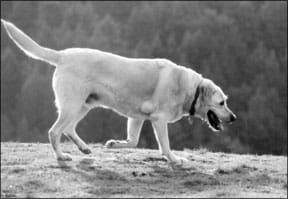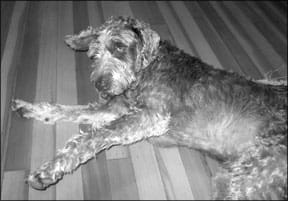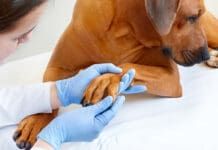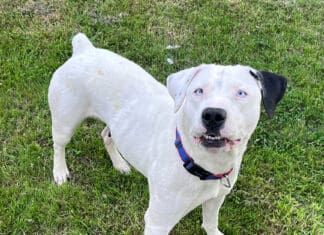Lumps, bumps, canine fatty tumors – call them what you will, but nobody likes to see her dog develop lipomas, those persistent little foothills that can sprout up on older dogs – and sometimes, not so-old ones.
Often soft and squishy to the touch, benign fatty tumors are not a threat to your dog’s health. (The exception is infiltrative lipomas, which can invade muscle tissue, but these are relatively rare.) While lipomas can be unsightly, many vets opt not to remove them unless they are in a location where their growth impedes a dog’s mobility.

288
But many holistic veterinarians see lipomas as far from innocuous. Instead, they stress, lipomas are symptoms of a bigger problem.
Holistic view
“For conventional veterinarians, lipomas are just something that happens, just like cancer happens,” says Marty Goldstein, DVM, of Smith Ridge Veterinary Center in South Salem, New York, author of The Nature of Animal Healing: The Definitive Holistic Medicine Guide to Caring for Your Dog and Cat. “What they don’t get is that lipomas are a result of what we’ve done to depress the metabolic functions and immune system of the animal.”
Dr. Goldstein believes that lipomas are a sign of improper fat digestion and a haywire metabolism, and that they often result from the unnatural commercial dog food diets that have become the norm today. “We’ve laden dog food with 50 to 65 percent carbohydrates, even though in nature wolves eat perhaps 1 to 3 percent grains.”
While few (if any) conventional veterinary practitioners would agree with this assessment (see “Conventional Medical Opinion,” next page), consider the case of Tembo, a Rhodesian Ridgeback who had his first lipoma before the tender age of one. Fed kibble and then a homemade diet heavy in grains and carbs, Tembo had constant allergies – corn gave him hives, and wheat summoned forth blistering yeast infections on his feet and in his ears.
“For the first seven years, the lipomas popped up like mushrooms,” remembers his owner, Elizabeth Akers of Concord, California, who had about 20 lipomas surgically removed from Tembo’s rib cage, legs, and chest. Some of the growths were small, others were tangerine-sized. “One on his groin was growing faster than the speed of light.”
Then, at age 7, Akers switched Tembo to a raw diet – and the lipomas responded as if she had flipped an “off” switch. “By the time he died at age 12, the only lipomas he had were in four places where they had been removed and had grown back again,” she remembers. “He had no new ones.”
Holistic veterinarians are quick to note that diet changes are not miracle cures: As in Tembo’s case, they may slow or even stop the growth of existing lipomas, or cause them to “organize,” or shrink. But expecting a wholesale disappearance of them is likely unrealistic.
Success is relative, Dr. Goldstein says. “If a lump is growing three inches every six months,” and after you make modifications in your dog’s diet and lifestyle, “it still gets bigger but it’s only growing one inch in that time frame, then you’re moving in the right direction.”
Holistic medicine doesn’t see diseases as unrelated entities that swoop in to disrupt health like so many flying monkeys at Oz. Instead, disease – or any disruption of the body’s functioning, no matter how seemingly mild, like lipomas – is a manifestation of a weakness with the body itself. In other words, there’s a Wicked Witch of the West lurking in the backdrop acting as dispatcher. Simply put, lipomas are a sign that there are deeper issues behind the scenes.
Many systems of healing have a name for the life energy that flows through the body and maintains good health. In homeopathy, for example, it is called the vital force. But no matter what you label it, what’s clear to holistic vets is that lipomas are evidence of the fact that the vital force is weakened and perhaps blocked – and likely has been for some time.
“One sign of vitality is the expression of symptoms, because that’s the body’s attempt to bring itself into balance,” explains classically trained homeopathic vet Michael Dym, VMD, of Morristown, New Jersey. By contrast, “lipoma patients have very weak symptoms,” as the body struggles to externalize its internal conflict in a kind of slow boil. In this scenario, “the patient has been ill on a deeper level for some time – it’s just that they don’t have adequate reactions, and have a very weak development of symptoms.”
For that reason, lipomas are not easy to treat, because making changes on that deep and profound a level doesn’t happen overnight.

288
“From a homeopathic perspective, any sort of lump or growth is generally thought to be an outcome of vaccinosis,” or the adverse effects of vaccination on the body, Dr. Dym continues. “Animals that are ill from prior vaccinations can have chronic warts, skin tags – and fatty tumors and lipomas.”
That’s not to say that you will be able to draw a direct line from last month’s rabies vaccine to your dog’s new growths. Instead, “we look at them as an outcome of weakness in a patient who’s not in the best health,” Dr. Dym says, because the life force has been affected by vaccines or toxins such as pesticides.
You’re outta here – not!
Lipomas can be unsightly, and some owners might be tempted to remove them for pure aesthetics. But because surgery only treats the symptom of the problem, not its root, most holistic veterinarians avoid it, except for lipomas that are so large or awkwardly placed that they impede a dog’s quality of life.
“The risk of removing the growth surgically is that it leaves the uncured disease to manifest at a deeper level, in a different form,” Dr. Dym warns. And from a homeopathic perspective, “when you remove a growth, you stimulate the vital force to greater activity. You can’t cure an apple tree of growing apples by cutting off its branches.” In fact, you might spur it to blossom even more profusely. And most lipomas tend to recur anyway.
While Dr. Goldstein agrees, he has had to remove lipomas that were in a compromising position, such as behind the nasal cavity, where they could obstruct breathing.
“Lipomas have their own finite capsule – you just scoop them out,” he says. A technique he employs during such surgeries is to roughen the tissue area around the lipoma, creating an inflammatory response. “This creates scar tissue that prevents the lipoma from growing back” – on that spot, at least.
Individualistic treatment
The classic homeopathic remedy used to treat tumors – and, while they are benign, lipomas are tumors – is Thuja, which is also often used for vaccine reactions. But Dr. Dym cautions against such a paint-by-number approach: Because lipomas are a symptom of a deep-seated imbalance in the body, he suggests a consultation with a homeopath to find the proper constitutional remedy – one that takes into account your dog’s own individuality – and treat the dog over time. Taking the wrong remedy – even one that might seem to fit the picture – “might stimulate a reaction that could highlight or activate” the very things you are trying to resolve, he warns. Traditional Chinese medicine has a different name for this life force that animates us all: chi. But that ancient modality also interprets lipomas as symptoms of a deeper imbalance.
“In Traditional Chinese veterinary medicine, lipomas are a type of ‘dampness’ called ‘phlegm’ that has stagnated in a particular area, usually an acupuncture channel such as the Gallbladder channel,” explains veterinarian Bruce Ferguson, DVM, MS, a practitioner and instructor in traditional Chinese veterinary medicine based in Perth, Australia. “Issues of ‘damp’ are usually, in the case of lipomas, caused by improper diet leading to a damage to the gastrointestinal system,” which is governed by the Spleen/Stomach meridian.
In traditional Chinese medicine, this channel “is responsible for moving a type of post-ingestive fluid around the body,” Ferguson continues. When a dog is fed a grain-based diet high in refined carbohydrates – as opposed to a more natural, meat-based diet – the channel gets clogged, and “gooey.”
In addition to dietary change, Dr. Ferguson says lipomas can be addressed with herbal formulas that tonify the spleen and resolve phlegm and dampness; acupuncture to help restore the movement of chi through the body, particularly the Spleen, and reverse stagnation; and occasionally gentle, non-traumatic massage such as Tui Na.
For his part, Goldstein sometimes prescribes Chi- Ko/Curcuma, a Chinese-herb formula indicated for resolving masses, specifically lipomas.
He also considers nutritional supplements such as L-carnitine and chromium picolinate, which assist in fat metabolism, as well as a product called Mega Lipo-Tropic, which helps digest and burn fat. Ditto for digestives enzymes that contain ox bile, a powerful fat emulsifier.
Improve basic health
No matter what modality you choose to deal with the underlying imbalances that might cause your dog’s lipomas, all dogs will benefit from these commonsense basics: good nutrition in the form of a biologically appropriate diet; good mental health, with a lifestyle that provides stimulating play, problem-solving, and social interaction; and no exposure to unnecessary vaccinations or toxins such as pesticides. And don’t forget exercise, Goldstein adds. “The only way to burn fat is to get your body – and your dog’s – up to its aerobic potential,” he says.

288
In the end, then, the good news about lipomas is that they aren’t life-threatening. But they are a signal that something is askew in your dog’s body.
“When I was in veterinary college, lipomas were described as benign masses that merely had a statistical rate of occurrence and did not ‘mean anything,’ ” Dr. Ferguson says. By contrast, traditional Chinese medicine teaches that “anything out of the ordinary has meaning, and usually indicates some type of imbalance.”
The task of the practitioner – and the observant, committed owner – is to discover and correct it.
Denise Flaim is the companion-animal columnist at Newsday on Long Island, New York. She owns four raw-fed Rhodesian Ridgebacks and is the author of The Holistic Dog Book: Canine Care for the 21st Century.







Hello WDJ
I have a Male Labrador approximately 34 kg weight has a lump type structure inside skin under chest of him but it is stagnant not increasing. Please tell me any natural or homeopathic medicine
Thank you Doctor
Just noticed a lipoma on the groin area of my doxie mix. This article is so interesting, especially the tie-in to TCM, as he has always had a very sensitive stomach with gastrointestinal upset. I got him from the side of the road when he was way too young to be away from his mother so he has had an alternative diet his whole life, ie raw, now very gently cooked. I plan to look into all aspects of healing mentioned. Much thanks!